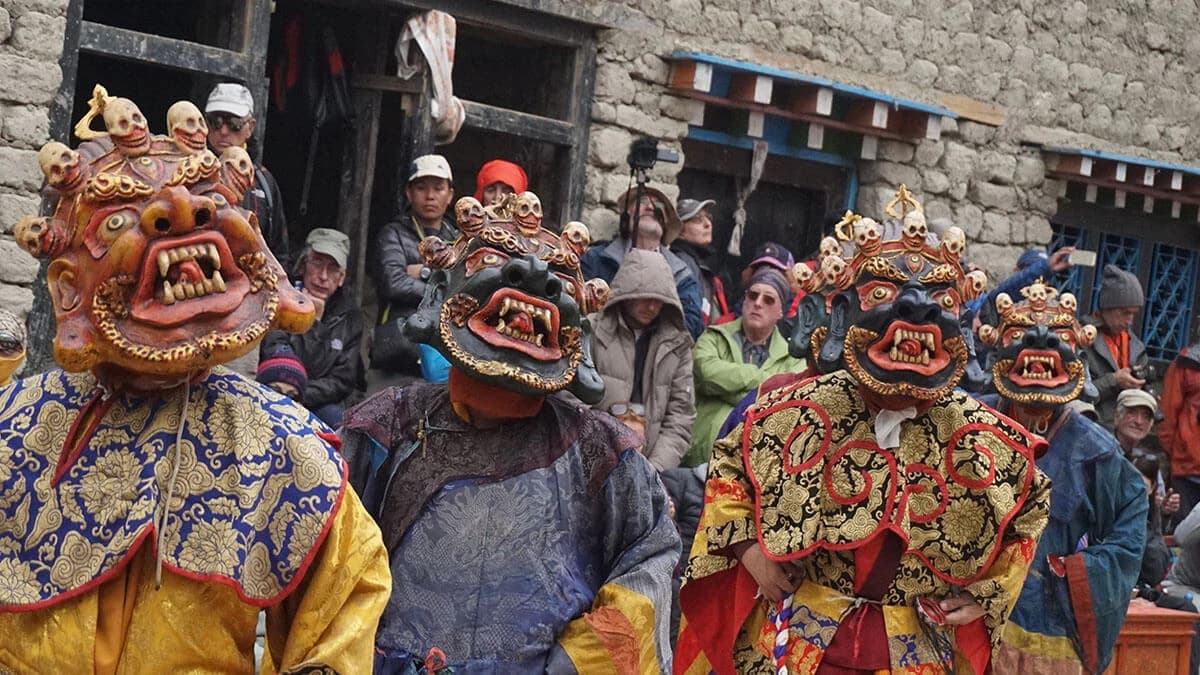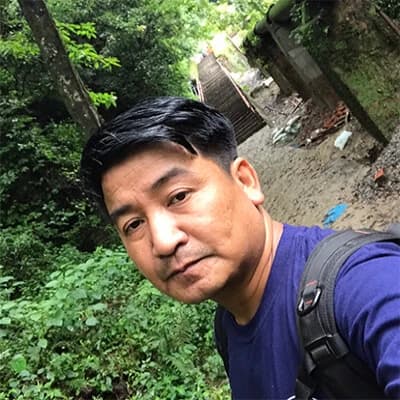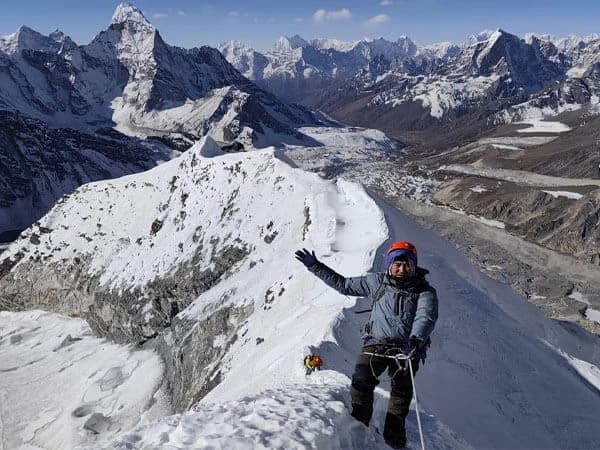Besides the high Mountains, Nepal is famous as the land of festivals, with over 50 festivals celebrated yearly. All national festivals have fixed dates, but astrologers set the religious festivals following the lunar calendar. All the events are marked with the same enthusiasm in large numbers, which is the best part of the festivals in Nepal. It used to be as entertainment with their passion hundreds of years ago.
List of festivals in Nepal
New Year:
In Nepal, it is called Navavarsha, as the official almanac begins on the first day of the first month of Baisakh, which is practiced as a Nepali New Year. Usually, it starts in the second week of April. People celebrate this New Year festival by socializing in different ways, like picnics and getting-together. This is also a National holiday.
Lhosar (Tibetan New Year):
The Tibetans, Sherpas, Manangays, and some of the Tamang and Gurungs who live in high altitudes of Nepal celebrate this festival as a new year in February. Kathmandu-Swayambhunath and Boudhanath are decorated with colorful prayer flags, and people perform their traditional dances wearing new clothes and jewelry and exchanging gifts. The festival begins with thoroughly cleaning the house and everything else. Each day is marked by a ritual like the throwing away of evil on the first day, and drinking alcoholic beverages is a part of the Lhosar Festival. Hence everyone will be pleased at this festival. The monks perform rituals in every monastery for the good of all humanity and hold ceremonies to eliminate evil spirits from the earth.
Saraswati Puja:
This is called Shree Panchami, and it is Saraswati birthday. Saraswati is the Goddess of Wisdom in Hinduism. The students and others worship the Goddess Saraswati to gain knowledge and wisdom with their deep faith. People celebrate the Saraswati Puja, or Shree Panchami, the birthday of Goddess Saraswati. Students worship their pen, pencil, copy, and Book on this auspicious day to please the Goddess and expect good luck and favor in their studies so they become wiser and more knowledgeable. People also throng around the idol of Goddess Saraswati, especially in Swayambhunath, and offer flowers, sweets, fruits, etc. Today, small children are taught to read and write; people write on stones and slabs with chalks and pencils. This day, which falls between January/February, is regarded as a very auspicious day for marriages, too, as it is believed that Goddess Saraswati herself blesses the couples. The astrologers usually fix the marriage date and time in Nepal.
Shivaratri:
This is one of the major festivals in Nepal. It means the Night of Lord Shiva and falls between late February and early March. In the Hindu religion, Lord Shiva is the most potent and kind God. So, the people worship Lord Shiva very much. One of the holiest shrines for Hindu people in Kathmandu is Pashupatinath Temple, where thousands and thousands of people gather to worship Lord Shiva on this occasion. He is the most worshipped God in the Hindu religion. Pashupatinath literally means the Lord of animals, as Lord Shiva is considered the guardian and protector of everything in the Himalayan Kingdom. On this holy day, Sadhu (Hindu holy men) and other devotees bathe in the sacred river Bagmati early in the morning and fast for the whole day. After that, devotees and sadhus smolder marijuana as believed to please Lord Shiva, which is legal for this occasion.
Holi:
This is called the Phagu festival, and playing with colors and water extends friendship and love between February and March in Nepal. This is the celebration day of killing Holika, a female demon who, together with her king brother, encouraged her to kill his son Prahlad, a passionate devotee of Lord Vishnu. People make different colors and enjoy throwing colors and water balloons at each other.
Ghode Jatra:
This festival is a magnificent horse parade performed at Tundikhel from March to April. The Army will perform a grand horse parade, horse race, and many other exciting sports activities with the Prime minister and other officials on this occasion. Hundreds of thousands will be gathered to see and enjoy this Festival at Tundikhe in Kathmandu.
Buddha Jayanti:
Buddha birth anniversary is celebrated yearly in Nepal on a full moon day in late April or early May. Which is also the day He achieved enlightenment and attained nirvana. Buddha was born in Lumbini in south Nepal more than 2500 years ago. On this occasion, people gather at Boudhanath, Swayambhunath, and many other Monasteries to worship the Lord Buddha. In addition, many people visit Buddha birthplace in Lumbini, chant prayers, burn butter lamps, and worship the Lord Buddha. In all three cities, Kathmandu, Patan, and Bhaktapur, the people carry images of Buddha, prayer flags, and banners through the streets in processions.
Gai Jatra(Cow Festival):
The cow festival is celebrated annually in late August or early September. This festival was started to be performed by a King named Pratap Malla, who had lost his son. Hoping to reassure his Queen, who was overcome with grief, he ordered his people, who had lost a family member during the past year, to bring out a procession in their honor. He hoped the Queen would realize she was not alone in her grief. Many people are seen leading a cow to bring the procession. Hence, the name is Gai Jatra. Nepal was a Hindu country, so the cow was Nepalese sacred and national animal. Hindus do not eat cow meat, which is regarded as a goddess. Hence, this is one of the most popular festivals in Nepal as it is full of absurdity, pleasantry, contempt, and sadness and has great fun. On this occasion, it is officially authorized to joke and satire anybody in the country, and it is widely celebrated in Kathmandu, Bhaktapur, and Patan.
Krishna Janmashtami:
Lord Krishna is the 8th incarnation of Lord Vishnu, and the birth anniversary of Lord Krishna is celebrated in August-September on the seventh day of the dark lunar fortnight. Many Hindu and Buddhist people go to the Krishna temple at Patan to worship, which is a very ancient Krishna temple. People worship and pray and offer flowers, food, sweets, and chant hymns in the name of Lord Krishna. There is a procession of trucks with portraits of Lord Krishna. People come to the temple from everywhere with musical instruments, singing devotional songs and praising Lord Krishna all day and night. The celebration primary focus is Lord Krishn temple at Patan Durbar Square. People decorate the temple with oil-wick lamps and incense, kept in flames the night with the devotees. It is believed that Lord Krishna was born at midnight and raised by a cowherd; hence, women shower their idols with butter, milk, and sweets. Many people worship Lord Krishna until early in the morning.
Teej:
This is a beautiful day for a Hindu married woman to celebrate with her husband in August-September. In Nepal, women are dressed in fantastic red Saris and sing and dance together at this festival. All women fast and pray to Lord Shiva for the protection, long life, health, and successful lives of their husbands and their families.
Indra Jatra:
In Nepal, this Indra Jatra festival is celebrated in the name of Lord Indra – the God of Rain and also the King of Heaven(Gods) by both Hindus and Buddhists in late August-early September; this festival lasts for eight days, singing, dancing, with mask, and rejoicing with the Chariot of Kumari- the living Goddess is taken with the salute through the main street of Kathmandu. Indra Jatra is one of the most stunning festivals and has much folklore intermingled with the acts of various deities. People make a ceremonial flag pole at Durbar Square, which is believed. This takes place on the twelfth day of the waxing moon. The pole is supposed to represent a similar flag- a pole given to Lord Indra by the God Vishnu. At Indra Chowk, the Akash Bhairav mask is brought out of the Bhairav temple and placed in front of the temple. It is then worshipped and decorated with colorful flowers and offers food, fruits, and sweets. Legend is that Lord Krishna cut off the head of a Kirati King( during the war of Maha-Bharat, five thousand years ago) when he showed up to fight for the rival side. It is said that his head flew to Kathmandu Valley. Since then, his head represents the heavy blue mask kept in the temple. During the Festival, People take this mask, show it to the public in the street, and perform their dances wearing a different type of mask. This dance is called the Lakhe dance. The chariot procession of the Living Goddess Kumari is another essential part of this festival. Kumari visits the street, sitting on her chariot, and is worshipped everywhere by the people.
Dashain (Bijaya Dasami):
This is Nepalese longest and biggest auspicious festival, celebrated for 15 days by all castes, communities, and faiths throughout the country from late September to early October. At this festival, people worship Goddess Durga numerously in all her manifestations. All family members celebrate the festival with ritual ceremonies every day. Many animals are sacrificed during this period of Dashain to celebrate this festival. People enjoy their time drinking, feasting, gambling, and visiting all their relatives.
Tihar:
This is the second biggest festival after Dashain, known as the fire festival, celebrated in October-November. On this occasion, people worship Laxmi, the Goddess of wealth, decorating their houses and lighting candles, oil lamps, and other lights to illuminate the places. It is believed that on this day, the Goddess Laxmi visits all the well-lit houses, hence the tradition of lighting oil-wick lamps. The festival lasts five days, and people worship cows, crows, and dogs. They are honored with a garland, vermilion, and delicious food. The last day of the Tihar brother day is called Bhai Tika as well; sisters put the Tika on their brother forehead and bless them for his protection and long, happy, and prosperous life, and Every brother offers a special gift to their sister. Then, they go door to door and sing a festival song.
Chhat:
Chhat is one of the most important festivals for people, especially in the Terai region. At this festival, people worship the Sun God. At the beginning of this festival, people prepare a variety of foodstuffs to offer the Sun God and use after a day-long fast. Then, all the devotees gather on the bank of the river to celebrate this festival and pray to the Sun God. The festival first day starts in the late afternoon when sunset begins. After that, all the devotees start offering different types of fruits and foods on the river bank and pray to the Sun God, then put their lighted oil-wick lamps on the river and make it float over the river surface. Devotee gathers the following day again before the sun rises, and as soon as it grows, they start to bathe, enter into the river water, and keep praying to Sun God and turning several times into the water. Finally, there will be a massive gathering on the bank of the river, and all the devotees will take the blessing food and fruits to distribute to family and friends.
Bisket Jatra (Festival):-
This festival is celebrated at Bhaktapur during the Nepali New Year in mid-April. There will be two chariots, one for God Bhairav and the other for his consort-Bhadrakali, Bhairavi. This festival lasts nine days, and visitors visit different shrines of the Goddess Durga. There will be a huge crowd to celebrate and watch this festival. The 70 ft pole with two large banners of cloth hanging from the top crosspiece is erected near the open shrine of Bhadrakali. During this festival, two Chariots are brought up to Bhadrakali. This is a fascinating contest between Bhaktapur upper and lower cities, pulling the chariot to be the first in position.
Seto-Machhendranath:
The Seto Machhendranath festival takes place in Kathmandu. This chariot with a long wooden tower is constructed at Durbar Marg near the statue of King Mahendra. The Seto Machhendranath chariot is brought to the Machhendranath temple at Jana Bahal near Indra Chowk in Kathmandu. During this festival, the chariot is pulled up to Lagankhel in the Lalitpur district. People gather around and worship the deity every place where the chariot stops. The chariot is then carried in a procession back to the temple at Jana Bahal in Kathmandu.
Rato Machhendranath Festival:
This festival was held in Patan from late April to early May. Rato Machhendranath is the God of rain and mercy, known as the God Lokeshwar. During this festival, a giant chariot is constructed at Patan, and many people pull it from place to place for more than a month to reach its final destination. Legend says that Lord Machhendranath resided in Assam, India, in ancient times. Then, a religious king and his two officials, Gorakhnath from Kathmandu, went to Assam in India to bring him back to Kathmandu. They used tantric mantras, changed Machhendranath into a bee, and brought him back to Nepal, putting him in a traditional bud vase. Hence, Machhendranath is also called a Bungadeo. Later, people built a town in his name called Bungamati and created a unique temple in the name of Lord Machhendranath at Bungmati in Lalitpur. During this festival, people make two chariots and demonstrate the second for Minnath, son of Machhendranath. Many enthusiastic crowds, including Newari musicians, participated in this festival. The Living Goddess- Kumari will bless all the devotees gathered to celebrate the festival. Wherever the chariot stops and halts the night, devotees come and worship the God Machhendranath, offering flowers, food, fruits, sweets, and rice, expecting good luck and rain for its cultivation. People enjoy playing music, performing dances, sacrificing animals, and sharing food. On the festival final day, Machhendranath Bhoto (an ornamented waistcoat) is displayed to the enormous crowd that gathers at Jawalakhel, Lalitpur. This festival is also popularly known as Bhoto Jatra.
Mani Rimdu:
Mani Rimdu is a Buddhist festival celebrated by the Sherpa people at Tengboche Monastery in the Everest region. Mani means prayers to God of compassion, Rim means the small red pellets, and Du means blessings. Monks from the Tengboche monastery perform dances wearing different types of masks and pray for the good of all humanity. These masked dances the monks perform are the most exciting and attractive to tourists. This festival lasts for three days: 1. The first day of the festival is the monks blessings. 2. The second day of the Festival of Monk masked dances and 3 days of Bondfire and blessings. Tengboche is also called a hidden valley, situated at the alleviation of 3800 meters on the way to the Everest Base Camp route, surrounded by beautiful snow-capped mountains. You can also see Mount Everest from here and many other beautiful mountains. Every year, many people come to know about this festival, both locals and tourists. Here is the Mani Rimdu festival trek to witness it.





